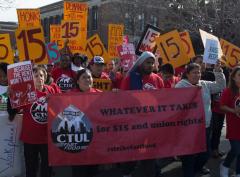A National Crisis: Millennial Student Loan Debt
The expansion of federal student aid is often considered a primary cause of rising tuition rates.

So I went to college for 10 years and at the end of it you see that dollar sign and you’re just like, ‘crap.’ It just was such a shock and I had no idea how I was going to pay it...I thought I was going to die.
A National Crisis: The Treacherous
Mountain of Millennial Student Debt
Neil tried to follow in the footsteps of his father, also a lawyer. But he ended up with far more debt than he had originally anticipated – $150,000 upon graduating.
And though he was diligent in making at least the minimum payment each month, Neil’s debt ballooned to $200,000 just years later.
Neil is one of the nearly 45 million Americans struggling to pay off a student loan balance. While our collective educational debt has passed the $1.6 trillion mark, this burden isn’t distributed equally among Americans.
Millennials like Neil hold the largest share of student loan debt. They owe, on average, more than $18,000. In contrast, when Generation X was finishing their studies, they had a 2004 median student loan balance of just $13,000.
Student loan debt has reached astronomical levels in the U.S., with 43 million Americans carrying an estimated $1.5 trillion in federal loan student debt and $119 billion in private student loans. The class of 2018 left school with an average of $29,200 in student loans. The financial burden of student loan debt proves heavier to bear for some borrowers than others.
What's Behind the Student Loan Debt Crisis?
There are several factors that have contributed to the student loan debt crisis in the U.S., beginning with rising tuition prices.
For the 2019-20 academic year, the average cost of tuition, fees, and room and board at a public four-year university totaled $38,330 for out-of-state students. The cost climbed to $49,870 for students at private four-year universities. 529 college savings plans can help with paying college expenses but only 21% of families use them, according to Sallie Mae's 2019 How America Pays for College Report. Instead, 51% of families borrow to pay for college, including loans taken out by both students and parents.
The lure of loan forgiveness may also be seen as a contributing factor. The federal Public Service Loan Forgiveness program offers student loan forgiveness for grads who pursue a career in public service. That's a tempting prospect, which may lead students to lean on loans more heavily, with the expectation that they'll be forgiven later. But, the program isn't permanent and could be altered or canceled, making it risky for borrowers to count on loan forgiveness.
The student loan debt crisis is compounded by the number of borrowers falling delinquent on their loans. As of the fourth quarter of 2019, 11.1% of student loan borrowers were 90 days or more delinquent or in default on their loans.6 This suggests that a substantial number of borrowers are struggling to keep up with their loan payments.
Certain Borrowers More Affected By the Debt Crisis
Student loan debt can take a toll financially, particularly if it keeps borrowers from pursuing other financial goals, or delinquency affects your credit rating. But, not every borrower feels the impact of student loan debt to the same degree.
Women Feel the Student Loan Debt Pain
According to an analysis by the American Association of University Women (AAUW), women own nearly two-thirds of student loan debt in the U.S., totaling almost $929 billion. Compared to men, women are more likely to finance a college degree and they tend to borrow more money to do so. That in itself isn't necessarily problematic, but the real student loan debt crisis happens when those same female grads have to start repaying their loans.
The gender pay gap often prevents women from making the same progress in paying off their loans as men. As of 2019, women working full-time earn approximately 82% of what men are paid. A lower income means less money to apply to student loan debt. Within the first four years after graduation, for instance, men paid off an average of 38% of their outstanding debt, according to AAUW, while women paid off 31%.
That slower debt payoff can make it more difficult for women to get ahead financially. Consider retirement savings. According to the 18th Annual Transamerica Retirement Survey, twice as many men versus women are very confident about their ability to retire with a comfortable lifestyle. Women have a median of $2,000 saved for emergencies, compared to $8,000 for men. Working men have an estimated median of $76,000 saved for retirement while working women have a median of $23,000.
Minorities Also Bear the Brunt of Student Loan Debt
Women aren't alone in the student loan struggle. According to the National Center for Education Statistics, 71% of Black students borrow federal loans to pay for attendance at four-year colleges, compared to 56% of white students. Hispanic and Black students are more likely to graduate with higher levels of debt than white students, and they're also more likely to default on their loans.
According to the AAUW research, Black women take on more student loan debt on average than any other group. Black and Hispanic women also struggled more than other groups with a slower debt repayment rate. Thirty-four percent of women overall and 57% of Black women who were repaying their student loans reported being unable to meet their essential expenses within the past year.
The Broader Economic Impact
Student loan debt can affect more than just individual borrowers; it also has the potential to have a wider economic impact.
The housing market, for example, has made a strong recovery since the 2008 financial crisis but according to one study, student loan debt delays homeownership for borrowers by an estimated seven years. That can cause supply and demand to swing out of balance if more homes go up for sale, but fewer buyers are shopping. That in turn, could lead to lower housing prices.
Student loan borrowers may also be more reluctant to use other types of credit, such as credit cards or car loans, meaning less interest and fee revenue for lenders and banks. When fewer people buy cars or homes, use credit cards or spend in general, which directly affects businesses and can slow down economic growth.
While not necessarily an upside, more students attending a college means a better-educated workforce, which can potentially lead to lower unemployment and higher tax revenues. But, the negative student loan debt crisis can't be ignored.
In the meantime, there's no clear solution to the student loan debt crisis. Finding ways to control rising higher education costs seems like an obvious step but implementing rules and regulations designed to do that is easier said than done. For students, the only recourse, for now, can be to educate themselves as much as possible about the costs of a college degree and the financial implications of taking on student loan debt before they borrow.




